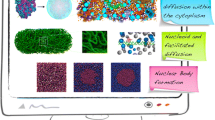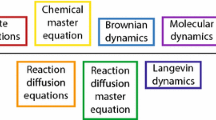Abstract
Several years ago, we decided to switch our main focus of interest toward the field of modeling cellular biology. Several reasons motivated this move: first cellular and molecular biology offer a fantastic new source of physical and mathematical problems. Second, to understand the function of cellular microdomains, modeling and computer simulations are necessary tools to organize and structure experimental observations. We review here some questions we have started to address.
Similar content being viewed by others
References
Araya R., Nikolenko V., Eisenthal K.B., Yuste R.: Sodium channels amplify spine potentials. Proc. Nat. Acad. Sci. USA 104, 12347–12352 (2007)
Bartfeld E., Grinvald A.: Relationships between orientation-preference pinwheels, cytochrome oxidase blobs, and ocular-dominance columns in primate striate cortex. Proc. Nat. Acad. Sci. USA 89, 11905–11909 (1992)
Biess A., Korkotian E., Holcman D.: Diffusion in a dendritic spine: The role of geometry. Phys. Rev. E 76, 021922 (2007)
Bishop K.M., Rubenstein J.L.R., O’Leary D.D.M.: Distinct actions of Emx1, Emx2, and Pax6 in regulating the specification of areas in the developing neocortex. J. Neurosci. 22, 7627–7638 (2002)
Bourne J., Harris K.M.: Do thin spines learn to be mushroom spines that remember?. Current Opinion Neurobiol. 17, 381–386 (2007)
A. Cheviakov, M. J. Ward and R. Straube, An asymptotic analysis of the mean first passage time for narrow escape problems: Part II: The sphere. SIAM Multiscale Modeling Simulation (2009), to appear.
Choquet D., Triller A.: The role of receptor diffusion in the organization of the postsynaptic membrane. Nat. Rev. Neurosci. 4, 251–265 (2003)
Dinh A.T., Pangarkar C., Theofanous T., Mitragotri S.: Understanding intracellular transport processes pertinent to synthetic gene delivery via stochastic simulations and sensitivity analyses. Biophys. J. 92, 831–846 (2007)
D. Fresche and D. Holcman, Should synpatic transmission be reliable. Preprint, 2009.
D. Fresche, A. Singer, Z. Schuss and D. Holcman, Complex dynamics in dendritic spines. Preprint.
Higley M.J., Sabatini B.L.: Calcium signaling in dendrites and spines: practical and functional considerations. Neuron. 59, 902–913 (2008)
Holcman D., Kasatkin V., Prochiantz A.: Formation of morphogenetic gradients and boundaries during early development. J. Theoret. Biol. 249, 503–517 (2007)
D. Holcman, E. Korkotian and M. Segal, Calcium dynamics in dendritic spines, modeling and experiments. Cell Calcium 37 (2005), 467–475.
D. Holcman and I. Kupka, The probability of an encounter of two Brownian particles before escape. J. Phys. A 42 (2009), art. ID 315210.
D. Holcman and I. Kupka, Mean escape time for a polymer inside a microdomain. Preprint.
Holcman D., Schuss Z.: Escape through a small opening: receptor trafficking in a synaptic membrane. J. Statist. Phys. 117, 191–230 (2004)
Holcman D., Schuss Z.: Diffusion through a cluster of small windows and flux regulation in microdomains. Phys. Lett. A 372, 3768–3772 (2008)
Holcman D., Schuss Z.: Diffusion escape through a cluster of small absorbing windows. J. Phys. A 41, 155001 (2008)
Kasatkin V., Prochiantz A., Holcman B.: Morphogenetic gradients and the stability of boundaries between neighboring morphogenetic regions. Bull. Math. Biol. 70, 156–178 (2008)
Kolokolnikov T., Titcombe M., Ward M.J.: Optimizing the fundamental Neumann eigenvalue for the Laplacian in a domain with small traps. Eur. J. Appl. Math. 16, 161–200 (2005)
Korkotian E., Holcman D., Segal M.: Dynamic regulation of spine-dendrite coupling in cultured hippocampal neurons. Eur. J. Neurosci. 20, 2649–2663 (2004)
Lagache T., Dauty E., Holcman D.: Quantitative analysis of virus and plasmid trafficking in cells. Phys. Rev. E 79, 011921 (2009)
T. Lagache, E. Dauty and D. Holcman, Physical principles and models describing intracellular virus particle dynamics. Current Opinion Microbiol. 12 (2009).
Meinhardt H.: A model of pattern formation in insect embryogenesis. J. Cell Sci. 23, 177–139 (1977)
Meinhardt H.: Complex pattern formation by a self-destabilization of established patterns: chemotactic orientation and phyllotaxis as examples. C. R. Biol. 326, 223–237 (2003)
Meinhardt H., Gierer A.: Generation and regeneration of sequences of structures during morphogenesis. J. Theoret. Biol. 85, 429–450 (1980)
Minsky A.: Abstract structural aspects of DNA repair: the role of restricted diffusion. Mol. Microbiol. 50, 367–376 (2003)
Monk N.A.: Restricted-range gradients and travelling fronts in a model of juxtacrine cell relay. Bull. Math. Biol. 60, 901–918 (1998)
C. Nüsslein-Volhard, Coming to Life: How Genes Drive Development, Kales Press, 2006.
Schuss Z.: Theory and Applications of Stochastic Differential Equations. Wiley, New York (1980)
Schuss Z., Singer A., Holcman D.: The narrow escape problem for diffusion in cellular microdomains. Proc. Nat. Acad. Sci. USA 104, 16098–16103 (2007)
Segal M.: Dendritic spines and long-term plasticity. Nat. Rev. Neurosci. 6, 277–284 (277))
Singer A., Schuss Z.: Activation through a narrow opening. Phys. Rev. E 74, 020103R (2006)
Singer A., Schuss Z., Holcman D.: Narrow escape and leakage of Brownian particles. Phys. Rev. E 78, 051111 (2008)
Singer A., Schuss Z., Holcman D., Eisenberg B.: Narrow escape I. J. Statist. Phys. 122, 437–463 (2006)
Singer A., Schuss Z., Holcman D.: Narrow escape II. J. Statist. Phys. 122, 465–489 (2006)
Singer A., Schuss Z., Holcman D.: Narrow escape III. J. Statist. Phys. 122, 491–509 (2006)
Karlin S., Taylor H.: A Second Course in Stochastic Processes. Academic Press, New York (1981)
Turing A.M.: The chemical basis of morphogenesis. Philos. Trans. B 237, 37–72 (1952)
S. Pillay, M. J. Ward, A. Peirce and T. Kolokolnikov, An asymptotic analysis of the mean first passage time for narrow escape problems. SIAM Multiscale Modeling Simulation (2010), to appear.
Ward M.J., Henshaw W.D., Keller J.B.: Summing logarithmic expansions for singularly perturbed eigenvalue problems. SIAM J. Appl. Math. 53, 799–828 (1993)
Ward M.J., Keller J.B.: Strong localized perturbations of eigenvalue problems. SIAM J. Appl. Math. 53, 770–798 (1993)
Ward M.J., Van De Velde E.: The onset of thermal runaway in partially insulated or cooled reactors. IMA J. Appl. Math. 48, 53–85 (1992)
Wolpert L.: Positional information and the spatial pattern of cellular differentiation. J. Theor. Biol. 25, 1–47 (1969)
Wolpert L.: One hundred years of positional information. Trends Genet. 12, 359–364 (1996)
Shmuel A., Grinvald A.: Coexistence of linear zones and pinwheels within orientation maps in cat visual cortex. Proc. Nat. Acad. Sci. USA 97, 5568–5573 (2000)
Wyman C., Kanaar R.: DNA double-strand break repair: all’s well that ends well. Ann. Rev. Genet. 40, 363–383 (2006)
A. Ziskind, Y. Shaul and D. Holcman, Nuclear organization constraints dsDNA repairs by NHEJ, a modeling insight. Preprint.
Author information
Authors and Affiliations
Corresponding author
Rights and permissions
About this article
Cite this article
Holcman, D., Kupka, I. Some questions related to modeling in cellular biology. J. Fixed Point Theory Appl. 7, 67–83 (2010). https://doi.org/10.1007/s11784-010-0012-1
Published:
Issue Date:
DOI: https://doi.org/10.1007/s11784-010-0012-1




